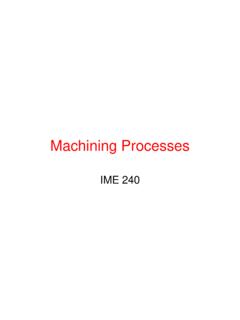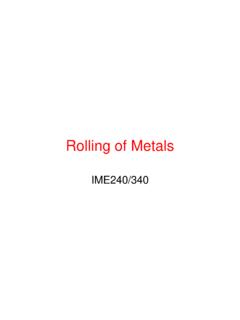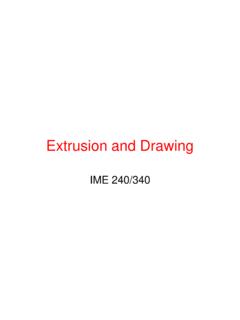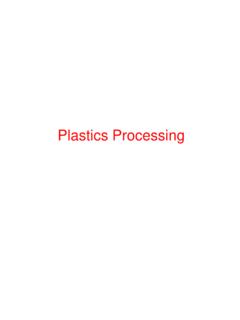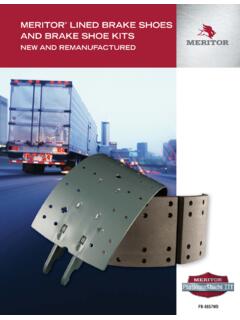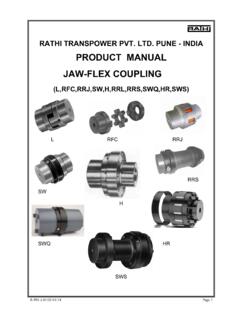Transcription of Sheet Metal Forming
1 Sheet Metal FormingIME 240/340 Sheet Metal Forming For products with versatile shapes and lightweight Dates to 5000 Products include Metal desks, file cabinets, appliances, car bodies, beverage cans Common materials: low-carbon steel, aluminum or titanium First take Sheet plate and cut into pieces by shearing, slitting, cutting, or sawing or produce from coil Then form into shapes by punching, blanking, stamping, embossing, bending, Forming , deep drawing, and a variety of other processesSheet Metal CharacteristicsTABLE the capability of the Sheet Metal to stretch without necking and failure; highstrain-hardening exponent (n)and strain-rate sensitivity exponent (m) elongationObserved with mild-steel sheets; also called Lueder s bands and stretcher strains; causesflamelike depressions on the Sheet surfaces; can be eliminated by temper rolling, butsheet must be formed within a certain time after (planar)Exhibits different behavior in different planar directions; present in cold-rolled sheetsbecause of preferred orientation or mechanical fibering; causes earing in drawing; can bereduced or eliminated by annealing but at lowered (normal)Determines thinning behavior of Sheet metals during stretching; important in deep-drawing sizeDetermines surface roughness on stretched Sheet Metal ; the coarser the grain, the rougherthe appearance (orange peel).
2 Also affects material stressesCaused by nonuniform deformation during Forming ; causes part distortion when sectionedand can lead to stress-corrosion cracking; reduced or eliminated by stress by elastic recovery of the plastically deformed Sheet after unloading; causesdistortion of part and loss of dimensional accuracy; can be controlled by techniques suchas overbending and bottoming of the by compressive stresses in the plane of the Sheet ; can be objectionable or can beuseful in imparting stiffness to parts; can be controlled by proper tool and die of sheared edgesDepends on process used; edges can be rough, not square, and contain cracks, residualstresses, and a work-hardened layer, which are all detrimental to the formability of thesheet; quality can be improved by control of clearance, tool and die design, fine blanking,shaving, and condition of sheetDepends on rolling practice; important in Sheet Forming as it can cause tearing and poorsurface quality; see also Section Formability is the ability of Sheet Metal to undergo shape change without failure by necking or tearing Cupping (Swift or Ericson) tests give some idea of formability(a) Yield-point elongation in a Sheet - Metal specimen.
3 (b) Lueder's bands in a low-carbon steel Sheet . Source: Courtesy of Caterpillar Inc. (c) Stretcher strains at the bottom of a steel can for household products.(a)(b)(c)(a) Forming -Limit Diagrams (FLD) Sheet Metal is marked with small circles, stretched over a punch, and deformation is observed in failure areas FLD shows boundary between safe and failure zones(a) Strains in deformed circular grid patterns. (b) Forming -limit diagrams (FLD) for various Sheet metals. Although the major strain is always positive (stretching), the minor strain may be either positive or negative. In the lower left of the diagram, R is the normal anisotropy of the Sheet , as described in Section Source: S. S. Hecker and A. K. Ghosh. Shearing(a) Schematic illustration of shearing with a punch and die, indicating some of the process variables.
4 Characteristic features of (b) a punched hole and (c) the slug. Note that the scales of the two figures are different. A blank is a properly sized piece of Sheet Metal removed from a much larger Sheet or coil by shearing Shearing is cutting by subjecting a workpiece to shear stresses Shearing starts with small cracks at points A, B, C, D which eventually grow and meet Rough fracture surfaces and smooth burnished surfaces result Shear angles or beveled edges often used on shearing diesShearing Parameters Clearance, c, between the punch and die typically between 2% and 10% of Sheet Metal thickness As clearance increases, sheared edge becomes rougher and zone of deformation becomes larger clearances are smaller for softer metals, thinner sheets, or larger holes Ratio of burnished to rough edges increases with.
5 Increasing ductility, decreasing clearance and thickness Faster punch speeds cause narrower sheared zones and less burr formation Burr height increases with increasing clearance, ductility, or dull tools Maximum Punch Force, F = T L (UTS)(product of thickness, sheared edge perimeter, and UTS)Shearing Operations Punching sheared slug is discarded Blanking slug is workpiece, surrounding area discarded Die cutting includes perforating (many holes), parting (separating into multiple pieces), notching (removing pieces from the edges), and lancing (leaving a tab) Fine blanking with 1% clearances produces very smooth and squared off edges(a)(b)(a) Comparison of sheared edges produced by conventional (left) and by fine-blanking (right) techniques.
6 (b) Schematic illustration of one setup for fine blanking. Source: Feintool Operations Slitting cutting off with 2 circular blades (can opener) Steel rules a die for shearing soft metals, paper, leather, and rubber into specific shapes (cookie cutter) Nibbling reciprocating die for successive, overlapping holes that shears intricate, flexible shapes Shaving trims excess material to clean sheared edges Compound and progressive dies perform several operationsSlitting with rotary and compound diesOther Methods of Cutting Sheet Metal Band saw Metal material removal process that produces chips as in other machining Flame cutting especially for thick steel plates, as in shipbuilding Laser-beam cutting newer process used with computer controlled equipment Plasma cutting high energy plasma formed by electric arc between tool and work material Friction sawing disk or blade that rubs against Sheet or plate at high speeds Water-jet cutting for metallic and non-metallic workpiecesLaser CuttingMechanical Stamp PressSequential Process StepsProgressive Die WorkCut-Off Die Design parts with straight parallel edges and jig-saw ends -minimizes scrap and can be produced on simplest cut-off dieCut Off OperationPart-Off DiePart Off Operation Design parts with straight parallel edges -reduces edge scrap and requires simpler part-off dieBlanking DieHole Punching DieBlank and Punch DieMulti-stage
7 StampingProgressive DieProcessing Limits minimum hole diametersCritical Dimensions in Design of Sheet Metal Blank* All dimensions > 2 x gage thickness**Feature Position Limits* Dimension > 4 x gage thickness*Reducing Scrap Scrap Metal can be as high as 30% Computer aided design and planning can minimize scrap Tailor-welded blanks are multiple pieces of flat Sheet butt-welded together and simultaneously stampedProduction of an outer side panel of a car body, by laser butt-welding and stamping. Source: After M. Geiger and T. Waste MaterialCNC Turret PressProgrammable machines for punching Sheet Metal using a turret of standard tools and corresponding diesCNC Turret PressTurret PressworkTurret of standard toolsTools for corner radiiAt least one blow per holeLong profiles require multiple blowsLaser or plasma cutting often added to reduce processing timesTurret Press Part FeaturesOnly possible in the upwards direction Turret Press Part LayoutBasic Die Bending OperationsBasic Die Bending Operations Springback is the elastic recovery following plastic deformation during bending Bending force is a function of material strength, length of bend (L), Sheet thickness (T) and size of die opening (W)Springback and Bending ForcesWkYLTP2 1343 ETYRETYRRR iifiWLTUTSP2)
8 ( For a V-dieSpringback ReductionBending Sheet Metal In bending, outer fibers are in tension while inner fibers are in compression Bend allowance is the length of the neutral axis in the bend, Lb = a (R+kT) k is a constant that ranges from (for R<2T) to (for R>2T) Engineering strain during bending: As R/T decreases, thetensile strain at outer fiberincreases and material eventually cracks 121 TReBendability and Minimum Bend Radius A 3T minimum bend radius means the smallest radius the Sheet can be bent to without cracking is 3 times thickness r is the tensile reduction of area of the Sheet Metal (a) and (b) The effect of elongated inclusions (stringers) on cracking, as a function of the direction of bending with respect to the original rolling direction of the Sheet .)
9 (c)Source: After J. Datsko and C. T. Yang.(c) Cracks on the outer surface of an aluminum strip bent to an angle of 90o. Note the narrowing of the top surface due to the Poisson effect.(a)(b) 150 rTRPress Brake FormingPress Brake FormingOther Bending Operations Roll-bending bending plates with a set of rolls Beading bending the periphery of Sheet Metal into a cavity of a die to improve appearance and eliminate exposed edges Flanging bending edges of Sheet Metal to 90 degrees Dimpling punching a hole, followed immediately by flanging the edges Hemming folding the edge of a Sheet over itself Seaming joining 2 edges of Sheet Metal by hemming Roll Forming Multiple rolls to form linear products similar to extrusionRoll FormingMulti-stage rolling process for producing elongated sectional products from Sheet metalTypical products are rain gutters and down spoutsCompetes with extrusion for some productsDeep Drawing DieDeep Drawing ProcessStresses in Deep DrawingCompressive hoops stresses in the flangeDrawing Parameters Wrinkling is caused by compressive (hoop) stresses that are induced as the blank moves into the die cavity Blankholder (or hold-down ring)
10 Pressure must be correct Too much pressure causes tearing, too little causes wrinkling Typically of the sum of the UTS and yield strength If Do-Dp< 5T, deep drawing may be successfully achieved without a blankholder Clearance is usually 7-14% Sheet thickness Deep drawability is expressed by the limiting drawing ratio Normal anisotropy R for rolled Sheet metalDrawing ParameterstwtrainThicknessSnWidthStraiR 4290450 RRRRavg poDDterPunchDiamenkDiameterMaximumBlaLDR Planar anisotropy determines whether earing will occur If DR=0 no ears form Ear height increases with DR Low DR and high Ravgis desired,but, tend to increase togetherDrawing Parameters2290450 RRRR DSource: M. in a drawn steel cup, caused by the planar anisotropy of the Sheet redrawingReverse redrawingReduces cup diameter and elongates wallsDeep Drawing and RedrawingIroningElongates and thins walls of the cupDeep DrawingThe Metal - Forming processes involved in manufacturing a two-piece aluminum beverage can Products.
